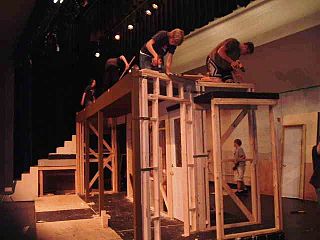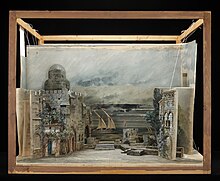
The following outline is provided as an overview of and topical guide to theatre:

Stagecraft is a technical aspect of theatrical, film, and video production. It includes constructing and rigging scenery; hanging and focusing of lighting; design and procurement of costumes; make-up; stage management; audio engineering; and procurement of props. Stagecraft is distinct from the wider umbrella term of scenography. Considered a technical rather than an artistic field, it is primarily the practical implementation of a scenic designer's artistic vision.

Theatrical scenery is that which is used as a setting for a theatrical production. Scenery may be just about anything, from a single chair to an elaborately re-created street, no matter how large or how small, whether the item was custom-made or is the genuine item, appropriated for theatrical use.

Set construction is the process undertaken by a construction manager to build full-scale scenery, as specified by a production designer or art director working in collaboration with the director of a production to create a set for a theatrical, film, or television production. The set designer produces a scale model, scale drawings, paint elevations, and research about props, textures, and so on. Scale drawings typically include a groundplan, elevation, and section of the complete set, as well as more detailed drawings of individual scenic elements which, in theatrical productions, may be static, flown, or built onto scenery wagons. Models and paint elevations are frequently hand-produced, though in recent years, many Production Designers and most commercial theatres have begun producing scale drawings with the aid of computer drafting programs such as AutoCAD or Vectorworks.

The Teatro Olimpico is a theatre in Vicenza, northern Italy, constructed in 1580–1585. It was the final design by the Italian Renaissance architect Andrea Palladio and was not completed until after his death. The trompe-l'œil onstage scenery, designed by Vincenzo Scamozzi to give the appearance of long streets receding to a distant horizon, was installed in 1585 for the first performance held in the theatre, and is the oldest surviving stage set still in existence. The full Roman-style scaenae frons back screen across the stage is made from wood and stucco imitating marble. It was the home of the Accademia Olimpica, which was founded there in 1555.
Scenography is a practice of crafting stage environments or atmospheres. In the contemporary English usage, scenography can be defined as the combination of technological and material stagecrafts to represent, enact, and produce a sense of place in performance. While inclusive of the techniques of scenic design and set design, scenography is a holistic approach to the study and practice of all aspects of design in performance.
A scenographer or scenic designer, also production designer, is a person who develops the appearance of a stage design, a TV or movie set, a gaming environment, a trade fair exhibition design or a museum experience exhibition design. The term originated in theater. A scenographer works together with the theater director to make the message come through in the best way they think possible, the director having the leading role and responsibility particularly for dramatic aspects - such as casting, acting, and direction - and the scenographer primarily responsible for the visual aspects or "look" of the production - which often includes scenery or sets, lighting, and costumes, and may include projections or other aspects.

In theatre and performing arts, the stage is a designated space for the performance of productions. The stage serves as a space for actors or performers and a focal point for the audience. As an architectural feature, the stage may consist of a platform or series of platforms. In some cases, these may be temporary or adjustable but in theaters and other buildings devoted to such productions, the stage is often a permanent feature.

United Scenic Artists, Local USA 829, formerly known as United Scenic Artists of America (USAA), is an American labor union. It is a nationwide autonomous Local of the International Alliance of Theatrical Stage Employees. It organizes designers, artists, and craftspeople in the entertainment and decorative arts industries. The organization was part of International Brotherhood of Painters and Allied Trades, however it reaffiliated with IATSE in 1999. United Scenic Artists was organized to protect craft standards, working conditions and wages for the entertainment and decorative arts industries.

A stagehand is a person who works backstage or behind the scenes in theatres, film, television, or location performance. Their work include setting up the scenery, lights, sound, props, rigging, and special effects for a production.
Joseph "Jo" Mielziner was an American theatrical scenic, and lighting designer born in Paris, France. He was described as "the most successful set designer of the Golden era of Broadway", and worked on both stage plays and musicals.

Boris Aronson was an American scenic designer for Broadway and Yiddish theatre. He won the Tony Award for Scenic Design six times in his career.
Performing arts – are art forms where the participant engages in a physical performance using their body, voice, language, or use of specific equipment for entertainment purposes.
A theatrical technician, also known as a theatrical tech, theatre technician, or theatre tech is a person who operates technical equipment and systems in the performing arts and entertainment industry. In contrast to performers, this broad category contains all "unseen" theatrical personnel who practice stagecraft and are responsible for the logistic and production-related aspects of a performance including designers, operators, and supervisors.
The following outline is provided as an overview of and topical guide to stagecraft:
The International Organisation of Scenographers, Theatre Architects and Technicians (OISTAT) is a non-governmental organization (NGO) founded in 1968 in Prague, Czech Republic. According to its founding name, the organization is mainly a network for theatre designers, theatre architects and theatre technicians around the world, made up of people associated with creating or studying live performances, including educators, researchers and practitioners. The organization has members from 51 countries, in the membership categories: Centre Member, Associate Member and Individual Member.
Theatre in the nineteenth century was noted for its changing philosophy, from the Romanticism and Neoclassicism that dominated Europe since the late 18th century, to Realism and Naturalism in the latter half of the 19th century, before it eventually gave way to the rise of Modernism in the 20th century. Scenery in theater at the time closely mirrored these changes and with the onslaught of the Industrial Revolution and technological advancement throughout the century, dramatically changed the aesthetics of the theater.
Theatre in the nineteenth century was noted for its changing philosophy from the Romanticism and Neoclassicism that dominated Europe since the late 18th century to Realism and Naturalism in the latter half of the 19th century before it eventually gave way to the rise of Modernism in the 20th century. Scenery in theater at the time closely mirrored these changes, and with the onset of the Industrial Revolution and technological advancement throughout the century, dramatically changed the aesthetics of the theater.
Jan Versweyveld is a Belgian theatre set designer, scenographer and lighting designer.













